Camino de Santiago Routes, how to Choose the BEST for you
Click here to download the image 
Do you remember the first time you thought about walking the Camino de Santiago? What inspired you? For some people, it was a movie, a book, a friend’s story about their Camino experience or a profound desire to become a pilgrim.
Now that you are determined to walk the Camino, it is time to choose the right Camino de Santiago route for you. As the saying goes, “there are as many Caminos as there are pilgrims”.
The Camino de Santiago begins from many cities in Spain, France, and Portugal. The best-known route is the French Way but there are other popular Camino de Santiago routes like the North and Portuguese Way.
The Primitive Way and Via de la Plata are also very beautiful and not as crowded. Having trouble choosing one? To make your decision easier, we will talk about the length and difficulty of each route as well as the landscapes and facilities you will find along the way. This information will surely make your decision easier.
The French Way: its history and landscape make it the most popular
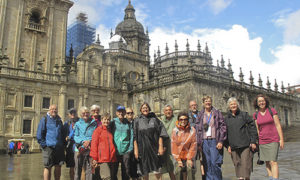
Out of the Camino de Santiago routes, the French Way is the most popular one. In 2013, more than 215,880 pilgrims walked it. This accounts for 70% of all the pilgrims who arrived in Santiago de Compostela.
The French Way is the most historic and picturesque of all the Camino de Santiago routes. It owes its heritage to many religious orders, among which the Templars were the most well-known. Along the route, you will find many monasteries and temples built in the Gothic and Roman style.
Would you like to have a social experience, to learn about new cultures and to enjoy beautiful landscapes?
If your answer is yes, the French Way is the right Camino de Santiago route for you. On this famous route, you will find pilgrims of all over the world. Be prepared to meet people and make very long-lasting friendships.
Is the French way too hard to walk?
It is a long way from Saint Jean Pied de Port to Santiago de Compostela. You will find easy, medium and difficult stages. Nevertheless, the most important thing is to plan the stages you want to walk based on your physical limitations and the amount of time that you want to spend on your pilgrimage. Always remember that you can customize your journey depending on your wishes and needs.
The starting point of the French way is traditionally Saint Jean Pied de Port. If you are interested in walking the full French way, Marly Camino has our Camino Plus: The French Camino from Roncesvalles option that covers 146 miles.
You won’t find two similar stages. You will walk through French villages, the amazing Pyrenees, Navarra villages, the amazing vineyards of La Rioja, the central plateau in Castilla and, in the end, you will arrive in Galicia. If you are a photography enthusiast, you will enjoy taking pictures of very different landscapes every day.
It is my first time and/or I am concerned with the amount of walking per day
If you want to experience the French Way, but you don’t want to walk for long, you can choose the Buen Camino from Sarria to Santiago or the easiest Camino route: The Buen Camino Lite. Both tours cover the last 100 km (62 miles) of the route, which is enough to get the Compostela.
The Buen Camino Lite, in particular, has shorter stages so you can feel more relaxed. Additionally, if this is a concern for you, you may want to do Camino with a company that can pick you up with their private vehicle in case you need to stop and be picked up at any point (such as Marly Camino).
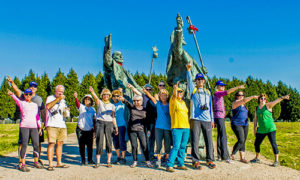
The best support and albergues of all routes
Of all the Camino de Santiago routes, the French Way is the best prepared to assist the pilgrim. It is well marked and has a full network of albergues. Some towns, like Sarria, live almost solely from the pilgrims, so they take great pride in their hospitality.
At Marly Camino, we offer you the opportunity to choose from a variety of itineraries that include the most beautiful spots of the French Way. For example: Buen Camino, Buen Camino Lite, Camino Plus and if you want to truly see the beauty of Galicia, starting at León, please check out The Camino from León to Santiago: The Galician Splendor
Do you like vineyards and charming villages? You will love the Portuguese Way
The beautiful vineyards, the beauty of the route and crossing the border between Portugal and Spain on foot has made the Portuguese Way the second most popular option of the Camino de Santiago routes.
This route has three major starting points: Lisbon, which is about a 600 km (371 miles) walk; Oporto, which is a 240 km (149miles) walk; and Tui, which is a 150 km (93 miles) walk. This lovely route goes through the Pontevedra and La Coruña provinces before heading to Santiago de Compostela.
It is a well-marked route whose yellow arrows will take you through villages, towns and historical cities. For example, legend holds that the Apostle’s disciples docked their ship in Padrón, one of the route’s villages, and brought the remains of the Apostle ashore.
Are you looking for a safe and beautiful walking route?
During your pilgrimage, you will walk through some highly populated areas, which means that you will find assistance and services quite easily.
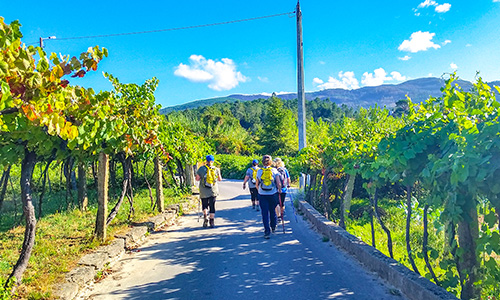
However, of all the Camino de Santiago routes, the Portuguese Way is perhaps the one with the most detours and options. You can walk north along the coast, the central area or the inner routes. One of the problems of this route is that the network of albergues is not as big as the one on the French Way.
The signs marking the Camino are constantly being updated and improved. Don’t worry, if you plan your Portuguese Way Camino trip with Marly Camino, we will handle everything for you. Our guides will take care of you the whole way.
Fun Fact: the use of the “viera” or Pilgrim’s shell started here
The famous pilgrim’s symbol has its origins on this Camino de Santiago route. It is said that a knight covered in shells emerged from the sea, between the coast of Porto and Vigo, which later started the tradition.
Do you love food? The North Coast Camino is the right Camino de Santiago route for you.
If you want to try some of the most amazing food in the world, go to the North of Spain. Their famous pinchos are known for being absolutely delicious. The North Way is the third most popular route. This route offers the green and beautiful landscapes of the Basque Country and the possibility of seeing the very cosmopolitan cities of San Sebastian and Bilbao.
This route has very diverse landscapes, but the number of pilgrims that you will find here is substantially lower than in the French way. From Irún to Santiago de Compostela, you will enjoy the Cantabric Sea, the Basque Country, Cantabria, Asturias and the natural beauty of Galicia.
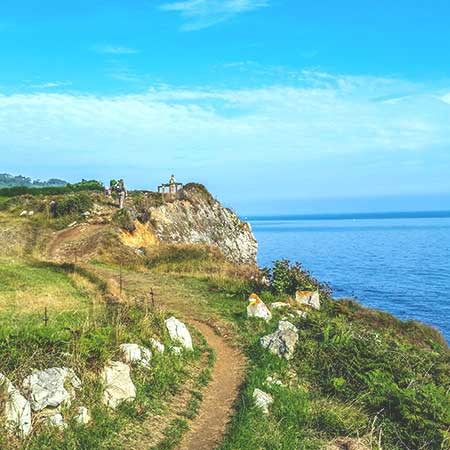
North Way Stages
The North Coast Camino traverses 197 km (122 miles), typically divided into eight stages. The stages range from 18 km (11 miles) to 33 km (20 miles). This route, longer than some options of the Portuguese Way, starts at Irún and takes you along the coast.
You may see the blue ocean and green forests at the same time in many places. You will pass through San Sebastian, Bilbao, Santander and Asturias on your way there.
Once pilgrims arrive to Oviedo, they can choose whether to go to Lugo following the Primitive Way (another Camino de Santiago route), or remain on the coast to reach Vegadeo and Ribadeo, from where they can continue to the town of Arzúa, which connects with the French Way.
Terrain and network of albergues
This route has a medium-low difficulty rating. There are mostly easy, flat stages with a few more challenging stages through the hills, but don’t worry, the route’s beautiful landscape will keep you motivated.
Of all the Camino de Santiago routes, this is the quietest one. The route’s pilgrim support infrastructure is still growing but it does not yet have the same amount of albergues as the French Way., but it does offer some pretty good options. Its route marking is good so you will see yellow arrows leading you all the way to Santiago de Compostela.
The Primitive Way: the first pilgrim´s route
The Primitive Way is the oldest of all the Camino de Santiago routes. This was the route of the first pilgrim, the medieval king Alfonso II. Despite its rich history, this route is not as popular as the French Way. It is a good option for those looking for a physically challenging route, away from big cities and paved roads.
Pilgrims are almost always surrounded by natural beauty and you will see very few paved roads. Oviedo, Lugo and Compostela are the biggest cities on the route. It joins the French Way in Melide.
Rich in history and natural beauty
Its history, landscapes and cultural richness make it the best option for the prepared and adventurous pilgrim. Despite not being one of the most popular routes among pilgrims, it has a very good network of albergues and is as well-marked as any other popular Camino de Santiago route.
Vía de la Plata: 1000 km of Roman history in Spain (Andalusian Camino )
The Vía de la Plata is the number one southern Jacobean route. As it is the longest of all Camino de Santiago routes, not many pilgrims walk it; which makes it perfect for those looking for an almost private experience.
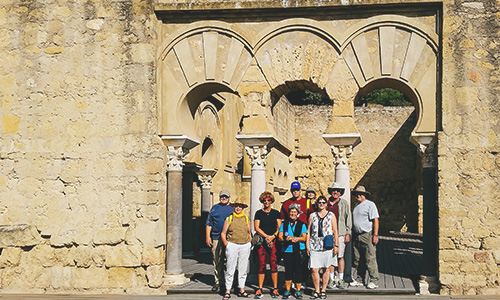 It goes through the regions of Andalucía, Extremadura, Castilla y León and Galicia. One of its characteristics is its great number of detour options. For example, in Zamora, you can choose whether to go north to meet the French Way at Astorga, or to go northwest through Ourense and head directly to Santiago.
It goes through the regions of Andalucía, Extremadura, Castilla y León and Galicia. One of its characteristics is its great number of detour options. For example, in Zamora, you can choose whether to go north to meet the French Way at Astorga, or to go northwest through Ourense and head directly to Santiago.
The Andalusian Camino, designed by Marly Camino, includes many of the best stages of the Via de la Plata. Andalucia with its incredible history, heritage, and a mix of different cultures is a rich source of inspiration.
Vineyards and olive groves
The Vía de la Plata travels along Roman roadways and natural paths, with barely any hills until reaching Galicia. The vineyards and olive groves in Andalucía and Extremadura are a treat for the eyes. You will also find meadows as well as oak and eucalyptus forests.
A well-marked route with long stages
This Camino de Santiago route is very well-marked. In fact, in Extremadura, there are granite cubes with the arc of Caparra next to the yellow arrows.
If the cube has a yellow tile, it means that the road is passable but it does not cross the original Roman roadway. If the tile is green, it means that it is part of the original roadway. And if the tile is green and yellow, the road is passable and belongs to the original roadway. The Via de la Plata is formed by the road that follows the yellow arrows next to the green and yellow, or yellow, tiles.
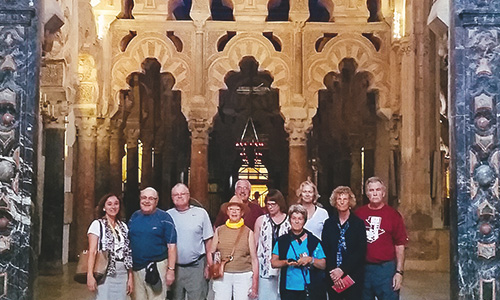
This route is known for its long stages, where sometimes there are dozens of kilometers between towns. Usually, albergues are 25 km (15 miles) apart from each other, so it is best to plan each stage carefully.
An ideal option for people walking on their own
Each year, 4000 thousand pilgrims choose Via de la Plata. Nevertheless, it is a bit of a solitary route. If you are looking for a true pilgrimage experience and a remarkable landscape, this is the right Camino de Santiago route for you.
However, during summer, temperatures tend to rise a lot. If you like this route, it is better to avoid July and August.
Time to make a choice
You can always choose the route and the stages that best suit you and define the distance to be walked every day and what to see. If you are traveling with Marly Camino, please contact us and tell us what kind of experience you are you looking for. We will be pleased to help you choose the right Camino de Santiago route for you.
